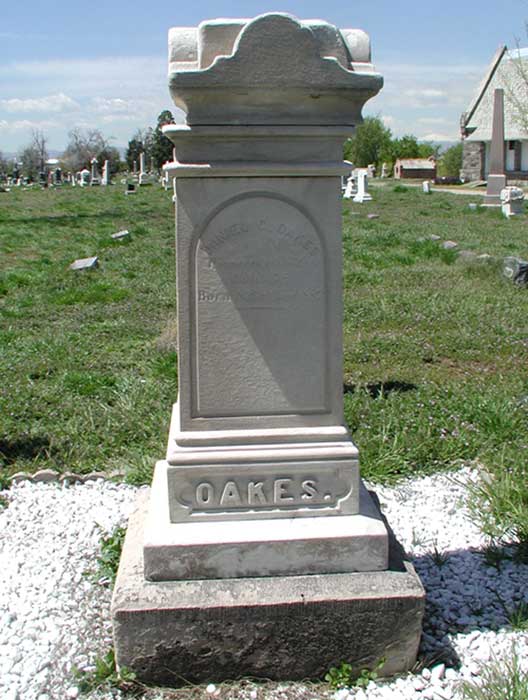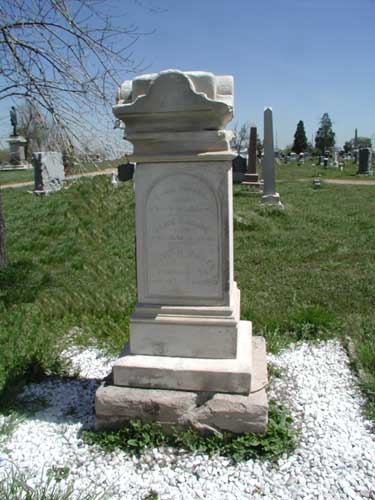| |
Daniel C. Oakes
Born in Maine in 1825, Daniel C. ( sometimes
referred to as Chess) Oakes moved across the country with his
parents three times: the first move was to Ohio where his mother
passed away; the second was a bit further west landing their
smaller family in Indiana. His father passed away in Iowa in 1847,
when D. C. was twenty-two years old. He took off for the California
gold fields in 1849, but returned to Iowa via ship which took him
through the Panama Canal and a brush with death when the sailing
vessel was dead in the water. Growing short on supplies of food, a
ship came to their rescue when the captain signaled the ship with the
Masonic signal for distress. Recovered from the ordeal of the
hardships at sea and the disappointment of California, D. C. married
Olive Maria Martin and they lived in Glenwood, Iowa.
Soon the urge to go west was back and D. C. started for Colorado.
Leaving in September of 1858 from Omaha with a party of prospectors,
he arrived in Denver on October 10th of that year, with
Olive staying behind. D.C. and party met up with the Green
Russell party to inspect their claims. Thinking that finding gold
would hold a good outcome for them, D. C. decided to return that
November to Iowa for the winter. Having had access to William Green
Russell’s journal, D. C. used it to write a pamphlet called the
“Pike’s Peak Guide & Journal” which touted the Colorado gold fields
and helped to lead green miners into thinking that gold could be
picked up off of the ground. From the book “The Great West” by
Ferdinand Vandeveer Hayden: “In the spring of 1859, Green Russell’s
journal was printed by Major D.C. Oakes, with descriptions of the best
routes to the new Land of Promise. This book, full of glowing
descriptions of the Land of Gold, was extensively circulated
throughout the Eastern States and caused thousands to leave their
homes and turn their faces westward to the land of untold treasures.”
This pamphlet, as it was also called, took off and helped to cause a
hundred thousand hopeful would-be gold miners to travel west to
Colorado, but this was somewhat short-lived. As D. C. returned
to Colorado in the spring of 1859 with a sawmill, he crossed paths
with the disappointed miners and their families. He felt their rage
when he saw that he was buried in effigy and almost lost his sawmill
when a large group, returning east, threatened to destroy it. The
group finally let D. C. pass after yelling “hard names” at him.
The sawmill was set up in Douglas County at Riley’s Gulch in the area
now known as Daniels Park. About this time Olive came to Colorado and
lived in a tent until D. C. could build their house. The Mill became
known as Oakes Mill or Oakesville which had a post office in 1860 and
was briefly considered as the Douglas County seat. D. C. Oakes’
“pioneer” mill was washed away in the flood of 1864. The account from
the book "History of Colorado" by Wilber Fiske Stone has D.C. Oakes
pioneer saw mill being established at Huntsville. Huntsville also has
a post office in which D. C. Oakes was the postmaster. It is very
possible that Oakes had two saw mills working to bring much needed
lumber to Denver, which was growing quickly.
D. C. had a lumber yard in Denver at Cherry Street near 5th
and he and his company erected buildings in Denver. D. C. served
as an election judge in Denver and some of the public meetings were
held in the offices of his business. He, also, was nominated as
Probate Judge in Douglas County. D. C. and Company advertised in
the Rocky Mountain News and this ad appeared in the October 21st
issue in 1861: “We are now prepared to furnish Lumber of assorted
grades either at our mills or Lumber Yard, corner of Cherry and 5th
Streets at the shortest notice, and at the Very Lowest Cash Prices.
Having two mills in operation capacitated to net 20,000 feet of Lumber
daily, enables us to fill bills immediately upon presentation.
All kinds of stock, wagons & c., taken in exchanges for lumber. Orders
left either with D. C. Oakes, Denver City, or J. E. S. Eayre, at the
mills, will receive immediate and prompt attention. D. C. Oakes & Co.”
The lumber business went on through 1865 when D. C. sold his mill and
was appointed Indian Agent by President Andrew Johnson. He established
the first Indian Agency for the Grand River and Yumpak Ute’s, and
served in this position through 1869. It was during the time that D.
C. was Indian Agent that he met Alexander Cameron Hunt, who had also
been an agent, General Kit Carson and Albert Gallatin Boone, related
to Daniel Boone. It was reported in the newspaper Colorado Transcript
of July 1869 that Major Oakes had been notified by the Interior
Department that his services were no longer needed as Indian Agent and
that an army officer had been ordered to supersede him. Many Denver
citizens asked that Oakes retain his position.
In 1870 the Oakes and Crull names appeared in the paper called the
Daily Register Call of Gilpin County. This could have been the
William Crull of
southern Douglas County as D. C. set up his second sawmill at
Huntsville in 1859
and may have met the rancher. The Bureau of Land Management records
show that Olive Oaks purchased 160 acres in Douglas County, in 1870,
close to the southern county line directly south of Greenland and
directly in line with where the railroad would come through (this is
the property that helped to make up the
Ben Lomond Ranch). The book “Walk With Our Pioneers a Collection”
from articles written by Josephine Lowell Marr mentions D. C. Oakes in
conjunction with land that Mrs. Coberly obtained for a town site,
stating that D. C. had a sawmill close by. The site of
Huntsville became Douglas County’s second post office with D. C.
becoming postmaster in 1862. In 1885 the newspaper of Castle Rock
reported that D. C. had purchased the cattle of Mr. Moorhead of the
Larkspur area (Moorhead had part of what is now the
Eagle Mountain Ranch), but that
D. C. was living in Denver.
In 1869 D. C. Oakes was appointed deputy U. S. Land surveyor and he
held this appointment until his death in 1887.

Daniel
Oakes memorial at Riverside Cemetery in Denver.

Olive Oakes memorial at Riverside Cemetery in Denver.
Thanks to the Colorado Historic Newspaper
Collection; the book Douglas County, Colorado A Photographic Journey;
the book Walk With Our Pioneers A Collection; the web site for the
Bureau of Land Management records; Denver Mountain Parks History page;
the book Kit Carson Days 1809 – 1869, the book History of Colorado,
History of Nevada, Colorado, and Wyoming, 1540-1888 by Hubert Howe
Bancroft, Frances Fuller Victor & Marvel of the New West by
William Makepeace Thayer on line at Google Books; the
web site for the Denver Library the article 59ers Directory Colorado
Argonauts 1858-59; Stone, Wilbur Fisk, ed.
History of Colorado.
Vol. 2. Chicago: The S. J. Clarke
Publishing Company, 1918; and the Susan Trumble landmark nomination for the
Pretty Woman Ranch.
|
|

